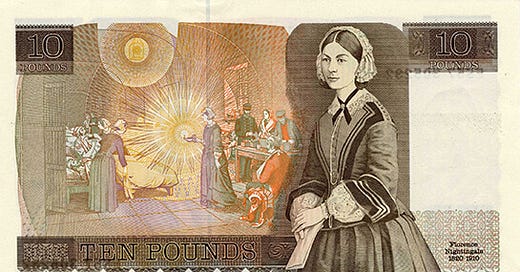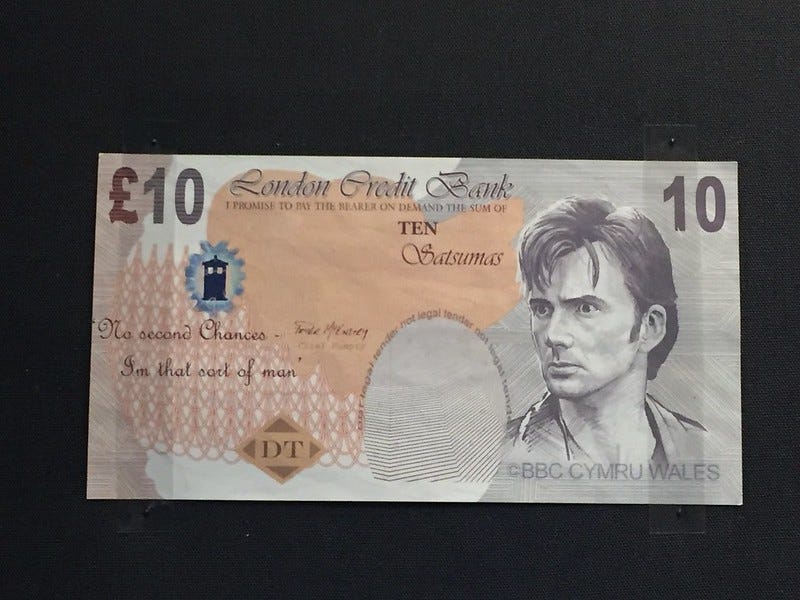Welcome to the Friday edition of Londonist: Time Machine for paying subscribers (with a generous teaser for everyone else).
19 non-royals have appeared on Bank of England banknotes. 14 of them were Londoners. (For a bit of fun, you might want to see how many you can jot down from memory or intuition before reading on.) In today’s newsletter, I look at who those 14 people were, and how else they’re commemorated in London.
First, an announcement and the History Radar.
📣📣 SUBSCRIBER DRINKS: Who’d like to join me in an historic London pub for a few drinks? Previously, we’ve met in the George, Ye Olde Cock Tavern and the Captain Kidd. I’m still deciding on the venue this time round (suggestions welcome, but needs to be relatively central), but I have fixed the date as Wednesday 11 September. This is open to paying subscribers only (and plus-ones). If you’d like to come along and meet other London history fans, then drop me a line on matt@londonist.com
History Radar
Upcoming events of interest to London history fans.
😷 DICKENS MUSEUM: On 26 August, representatives from the Old Operating Theatre pop up at the Charles Dickens Museum in Bloomsbury for an object-handling session, where you can learn about the health hazards in Victorian London. Get up close to 19th-century medical and surgical objects as you hear tales of stinking rivers and choking smog. The museum will also be showing off some unpublished letters from Dickens family to "Plorn" Dickens, the youngest son of Charles and Catherine.
🤣 HISTORICAL COMEDY: On 27 August,YouTube and TikTok comedy star Adrian Bliss is at Union Chapel, performing his latest character comedy show which shines the spotlight on the lesser-known figures from history. Such characters include the ferret who posed for Leonardo da Vinci, the servant who oversaw Henry VIII's toilet time, and the famous horse who thrilled Queen Victoria.
😹 CARTOON MUSEUM LATE: The Cartoon Museum in Bloomsbury stays open late on 29 August for an evening focusing on the origins of comics. Browse a selection of original comics pages and artwork, dating back as far as Rex Maxon's Tarzan (1931) and EC Segar's Popeye (1933).
🌳 LONDON'S STREET TREES: Not entirely history-focussed, but friend and fellow Substacker
is at Stanfords in Covent Garden, discussing the updated third edition of his book London's Street Trees. Hear about the impressive range of species — more than 400 — which grow on London's roads, making the capital something of an arboretum.🪙 MUDLARKING FESTIVAL: On 30 August, Southwark Cathedral hosts a mudlarking and heritage crafts festival. Meet mudlarks — including author Lara Maiklem — to hear about their finds on the Thames foreshore, and watch demonstrations of crafts including stone and wood carving, flint knapping, bee keeping and falconry.
🎸 THE KINKS: Here's a treat for fans of quintessential London rock band The Kinks: to mark 60 years since the group's formation, take a three-hour guided tour on a 1961 Routemaster, visiting venues and locations where The Kinks performed, recorded and hung-out. After this, watch a show by the 'Konks' tribute band, playing renditions of all of The Kinks' hits and lesser known album tracks. It’s on 30 August.
🪦 BROMPTON CEMETERY: On 1 September, the Friends of Brompton Cemetery host their annual open day today, with a whole slew of tours (general, catacombs, trees), alongside birds of prey, pedicab rides, children's storytelling, dog grooming advice and a lot more.
Londoners of Note(s)
Only the most celebrated names in the land (and Sir John Houblon) get to be on Bank of England banknotes. Newton, Darwin, Austen, Nightingale, Dickens… getting your countenance on the currency is one of the highest honours, reserved for our greatest achievers (and Sir John Houblon).
I was surprised to learn that this tradition of putting the noteworthy on notes is relatively recent. The likeness of the Queen did not appear until as late as 19601, and the first non-royal was William Shakespeare in 1970, on the £20 note. More soon followed on other denominations, with a change of face every 10 to 20 years. So far, the roll of honour has included 16 men and just three women. I thought it’d be interesting to take a look at this exclusive club of 19 people (not including monarchs, or the representation of Britannia). Who were they, how many of them were Londoners, and how else are they memorialised across town?
£1 note

Sir Isaac Newton 1978-1988
Ah, the £1 note. I remember these fondly from childhood. Sir Isaac Newton was the only non-Royal ever to feature on this denomination. It lasted just 10 years before inflation diminished the pound, and coins made more sense.
Newton is a doubly appropriate candidate for the currency. He made some of the most important discoveries of all time, insights into the universe that are still studied by school children 300 years after his death. But he was also Master of the Mint for almost 30 years, a role that gave him responsibility over the nation’s coinage.
Newton is memorialised in many places across London, most notably by the monumental sculpture by Sir Eduardo Paolozzi in the forecourt of the British Library (it’s based on an illustration by William Blake). Newton’s Blue Plaque is on Jermyn Street.
£5 note
(Names in bold were Londoners for significant parts of their life. Dates refer to the availability of the banknote, not the subject’s life years!)
Sir Arthur Wellesley, 1st Duke of Wellington 1971-1991
George Stephenson, 1990-2003
Elizabeth Fry, 2002-2017
Winston Churchill, 2016-
Three out of four fivers are decorated with Londoners. The Duke of Wellington was, of course, one of the victors of the Battle of Waterloo, and later Prime Minister. Elizabeth Fry was a prison reformer and prominent quaker. Winston Churchill needs no introduction.
Two of the three are closely associated with London visitor attractions. The Duke’s former home of Apsley House (dubbed “Number 1, London”) on Hyde Park Corner is managed by English Heritage, and is notable for the 11-foot statue of a naked Napoleon in the stair well. I doubt Churchill furnished his home with a scantily-clad likeness of Hitler. What he did have was a reinforced communications bunker beneath Whitehall. Now named Churchill’s War Rooms, you’re prepared to stump up the £32 entry fee.
Sadly, Elizabeth Fry has no museum, though she does have a number of memorials across town. One of the blocks of the Home Office is named after her, she has a statue inside the Old Bailey, and various other busts here and there. A City of London plaque marks her former home just west of Bank junction.
Railway pioneer George Stephenson never lived in London and is not commemorated here, though his son Robert Stephenson, also a rail bigwig, has a statue at Euston. Stephenson’s Rocket (built by Robert) is on display in the Science Museum.
£10 note
Florence Nightingale, 1975-1994
Charles Dickens, 1992-2003
Charles Darwin, 2000-2018
Jane Austen, 2017-
Four world-famous figures here, who need no biography, but can be alliteratively summarised as nurse, novelist, naturalist, ‘nother novelist.
All three London subjects have their own cultural centres. The Florence Nightingale Museum at St Thomas’s hospital explores the Lady of the Lamp’s life, and the history of nursing more generally. Charles Dickens’s home on Doughty Street remains much as he would have known it when he wrote his earliest novels there. Charles Darwin, meanwhile, has a Blue Plaque on Gower Street but is more closely associated with Down House in Bromley. It was here that he formulated his ideas of evolution by natural selection. Darwin has a prominent statue in the Natural History Museum, Nightingale in Waterloo Place, but Dickens has none2. This surprising omission was at the author’s own request; he wanted his life’s work to be his memorial.
Jane Austen stayed in London on many occasions (as plaques in Chelsea and Covent Garden attest), but she can’t really be claimed as a Londoner.
Finally, another noted Londoner features on a prop banknote on show at the British Museum. The dodgy tenner bears the likeness of the Tenth Doctor from Doctor Who, and was used in the 2006 Christmas special, The Runaway Bride. Although the Doctor grew up on the planet of Gallifrey, he is a regular visitor to London (see my map) and has spent many extended stays in the capital (he even enrolled his granddaughter Susan in a Shoreditch school). I’m calling him/her a Londoner.






